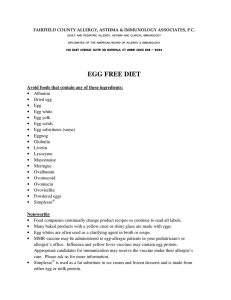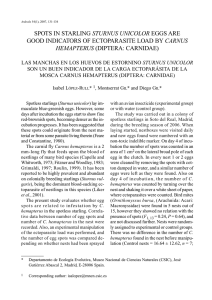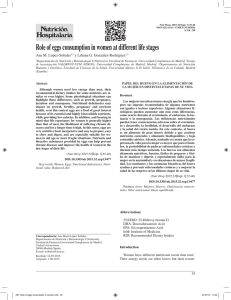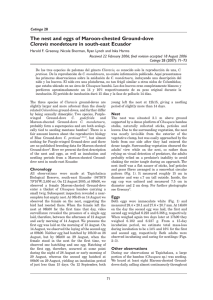is the house sparrow passer domesticus an indeterminate or a
Anuncio
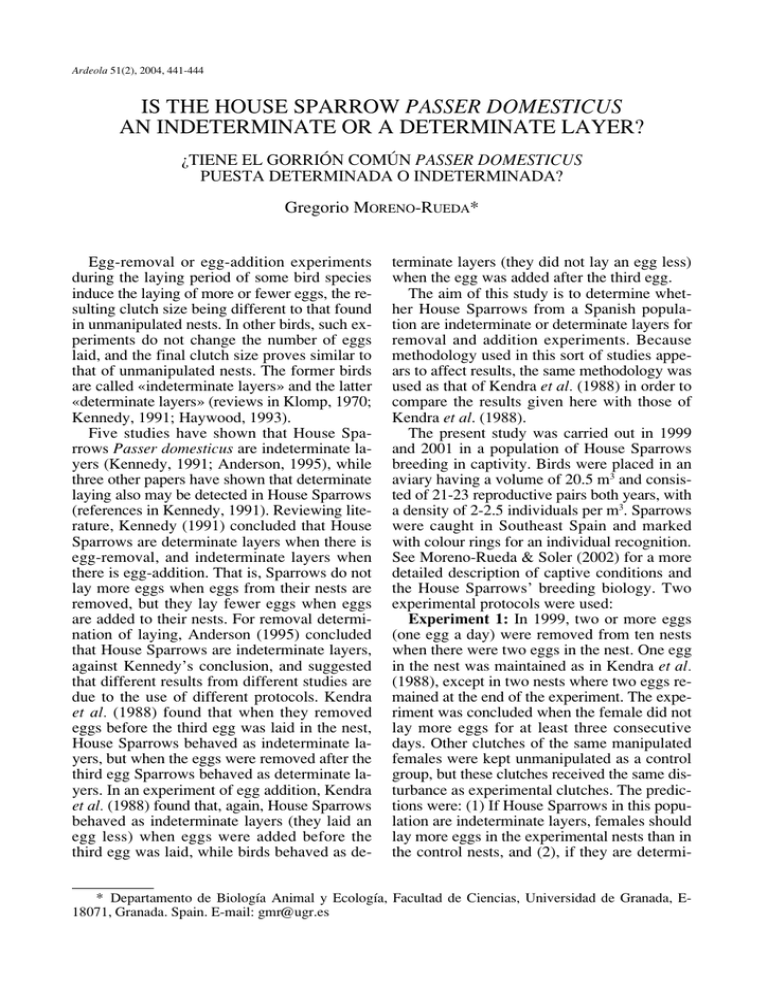
Ardeola 51(2), 2004, 441-444 IS THE HOUSE SPARROW PASSER DOMESTICUS AN INDETERMINATE OR A DETERMINATE LAYER? ¿TIENE EL GORRIÓN COMÚN PASSER DOMESTICUS PUESTA DETERMINADA O INDETERMINADA? Gregorio MORENO-RUEDA* Egg-removal or egg-addition experiments during the laying period of some bird species induce the laying of more or fewer eggs, the resulting clutch size being different to that found in unmanipulated nests. In other birds, such experiments do not change the number of eggs laid, and the final clutch size proves similar to that of unmanipulated nests. The former birds are called «indeterminate layers» and the latter «determinate layers» (reviews in Klomp, 1970; Kennedy, 1991; Haywood, 1993). Five studies have shown that House Sparrows Passer domesticus are indeterminate layers (Kennedy, 1991; Anderson, 1995), while three other papers have shown that determinate laying also may be detected in House Sparrows (references in Kennedy, 1991). Reviewing literature, Kennedy (1991) concluded that House Sparrows are determinate layers when there is egg-removal, and indeterminate layers when there is egg-addition. That is, Sparrows do not lay more eggs when eggs from their nests are removed, but they lay fewer eggs when eggs are added to their nests. For removal determination of laying, Anderson (1995) concluded that House Sparrows are indeterminate layers, against Kennedy’s conclusion, and suggested that different results from different studies are due to the use of different protocols. Kendra et al. (1988) found that when they removed eggs before the third egg was laid in the nest, House Sparrows behaved as indeterminate layers, but when the eggs were removed after the third egg Sparrows behaved as determinate layers. In an experiment of egg addition, Kendra et al. (1988) found that, again, House Sparrows behaved as indeterminate layers (they laid an egg less) when eggs were added before the third egg was laid, while birds behaved as de- terminate layers (they did not lay an egg less) when the egg was added after the third egg. The aim of this study is to determine whether House Sparrows from a Spanish population are indeterminate or determinate layers for removal and addition experiments. Because methodology used in this sort of studies appears to affect results, the same methodology was used as that of Kendra et al. (1988) in order to compare the results given here with those of Kendra et al. (1988). The present study was carried out in 1999 and 2001 in a population of House Sparrows breeding in captivity. Birds were placed in an aviary having a volume of 20.5 m3 and consisted of 21-23 reproductive pairs both years, with a density of 2-2.5 individuals per m3. Sparrows were caught in Southeast Spain and marked with colour rings for an individual recognition. See Moreno-Rueda & Soler (2002) for a more detailed description of captive conditions and the House Sparrows’ breeding biology. Two experimental protocols were used: Experiment 1: In 1999, two or more eggs (one egg a day) were removed from ten nests when there were two eggs in the nest. One egg in the nest was maintained as in Kendra et al. (1988), except in two nests where two eggs remained at the end of the experiment. The experiment was concluded when the female did not lay more eggs for at least three consecutive days. Other clutches of the same manipulated females were kept unmanipulated as a control group, but these clutches received the same disturbance as experimental clutches. The predictions were: (1) If House Sparrows in this population are indeterminate layers, females should lay more eggs in the experimental nests than in the control nests, and (2), if they are determi- * Departamento de Biología Animal y Ecología, Facultad de Ciencias, Universidad de Granada, E18071, Granada. Spain. E-mail: gmr@ugr.es 442 MORENO-RUEDA, G. nate layers, they should lay not statistically significant different number of eggs between experimental and control nests. Because Kendra et al. (1988) showed that House Sparrows behaved as indeterminate layers when eggs were removed before the third egg, but as determinate layers when the eggs were removed after the third egg had been laid, experiments performed when there were more than two eggs in the nests were not included. Experimental and control clutches were distributed through the whole breeding season. A sign test was used to compare the number of eggs laid by each female in an experimental clutch with the mean number of eggs laid in control clutches. Clutch sizes are expressed as mean ± standard deviation. Experiment 2: In 2001, one egg was added to ten nests, while one egg was switched between five nests as control. Eggs used in the experiment were taken from nests where eggs were laid synchronously. Eggs were introduced into the nest before the third egg of the clutch was laid, as in Kendra et al.’s (1988) study. Both operations were carried out during the second and the third clutch. If House Sparrows were indeterminate layers, the egg-added females should have laid fewer eggs than the egg-switched females. A U-test was used for comparisons because females in both groups were not the same ones. In experiment 1 (egg removal experiment), two eggs were removed in 8 out of 10 nests, while in the other two nests 3 and 6 eggs were removed, respectively. Only one female seemed to show indeterminate laying, because she laid seven eggs in eleven days, and six of them were removed. However, the mean clutch size in control nests of this female was very high (4.7), and it is possible she received parasitic eggs or began a new clutch (see Anderson, 1989; Kennedy, 1991). The numbers of eggs laid in the experimental and the control nests were similar (experimental nests: 3.8 ± 1.39; control nests: 3.5 ± 0.56; Sign test; P = 0.70, n = 10). Mean clutch size that year (experimental clutches excluded) was 3.6 ± 0.97 (n = 24; Moreno-Rueda & Soler, 2002). Experimental clutches were usually deserted when only one or two eggs remained in the nest at the end of the experiment. In experiment 2 (egg-added and egg-switched treatments), the number of eggs laid reArdeola 51(2), 2004, 441-444 mained similar in both groups when the manipulation was carried out (egg-added group: 5.3 ± 0.67, n = 10; egg-switched group: 5.4 ± 1.14, n = 5; Mann-Whitney U-test, Z = 0.06, P = 0.95). It is possible that females in both groups could recognise the apparent brood parasitism and laid one egg less in both groups (Kendra et al., 1988; Lyon, 2003). However, given that clutch size in unmanipulated clutches was not statistically different in the first, second and third clutches (Friedman ANOVA, χ 2 = 3.65, P = 0.16, n = 15), the number of eggs laid in both groups of experimental clutches (egg-added and egg-switched pooled) were compared with the unmanipulated clutches of the first clutch. Differences were significant, but the trend was the opposite of that predicted (unmanipulated nests: 4.8 ± 0.41; experimental nests: 5.3 ± 0.82; Sign test, P < 0.05; n = 15), probably as a consequence of seasonal variation in clutch size (Moreno-Rueda & Soler, 2002). Another possibility is that females increased clutch size in response to apparent parasitism, a strategy that may reduce the survival prospects of the parasitic chick (Soler et al., 2001), but this strategy has never been described in studies with more adequate controls, including that for the House Sparrow (Kendra et al., 1988). Results of both experiments suggest that the House Sparrows used in this study are determinate layers, although some females with indeterminate laying may exist. The same methodology was used as Kendra et al. (1988), and results were the opposite. Therefore, methodology did not account for differences between this study and other studies (e.g. Kendra et al., 1988). Captivity might account for those differences, but it would not explain why other studies done in the field have also found that House Sparrows have determinate laying (Brackbill, 1960; Anderson, 1989). In short, methodology does not seem to be the cause of the results found in this study. In all, five studies have shown that the House Sparrow is an indeterminate layer (references in Kennedy (1991), and Anderson (1995)), while four others have demonstrated that determinate laying also exists in this species (references in Kennedy (1991), and the present study). These results, in comparison with those from Kendra et al. (1988) and others, suggest that some populations of the House Sparrow IS THE HOUSE SPARROW PASSER DOMESTICUS AN INDETERMINATE OR A DETERMINATE LAYER? can show determinate laying while others can show indeterminate laying. The relationship between follicles produced and eggs laid is the factor determining the type of laying (Klomp, 1970). Some birds produce the same number of follicles as the number of eggs they will lay, while others produce more follicles than eggs to be laid. The latter usually, but not always, show indeterminate laying (Kennedy, 1991). Other additional factors are necessary for indeterminate laying to occur. Probably, ecological factors should account for differences that exist among populations. Egg destruction and intraspecific brood parasitism have been suggested as selective factors favouring indeterminate laying (Kennedy, 1991). Addition indeterminate laying (in the sense of Kennedy, 1991) can be profitable against intraspecific brood parasitism because hosts may reduce their clutch size to the optimal one when they are parasitized at the beginning of a laying sequence (Kendra et al., 1988). Then, intraspecific brood parasitism could account for differences among different populations, but intraspecific brood parasitism rates for House Sparrows are low (2%, Veiga & Boto, 2000) or inexistent (e.g., Cordero et al., 1999). Interpopulational correlations among intraspecific brood parasitism rates and sort of laying would be necessary to test this possibility. Partial egg destruction is due principally to conspecifics (Veiga, 1990). Nest predation usually destroys all eggs, and when it occurs it should be more profitable for birds to renest in other site. Partial egg destruction could also account for differences among populations because it favours the evolution of removal indeterminate laying (sensu Kennedy, 1991), but its rate is low (9-12% for all states since eggs to fledglings; Veiga, 1990). Other ecological factors should not be discarded as selective pressures for the evolution of the sort of laying. RESUMEN.—Diferentes estudios sobre el tipo de puesta (determinada o indeterminada) que posee el Gorrión Común (Passer domesticus) han encontrado resultados distintos. Una posible explicación para estas diferencias estriba en los distintos métodos de estudio utilizados. En el presente trabajo se analizó experimentalmente el tipo de puesta existente en una población española de Gorrión Común. Para ello se realizó un experimento en el que se retiraron 443 huevos de la puesta de 10 hembras, y otro experimento en el que se añadió un huevo a la puesta de otras 10 hembras. En ambos experimentos las hembras tratadas pusieron un número de huevos similar al de los controles. Estos resultados sugieren que los Gorriones Comunes de esta población tienen puesta determinada, en contraste con otros estudios que utilizaron el mismo diseño experimental. Por tanto, la existencia de diferencias entre poblaciones en el tipo de puesta es la explicación más plausible para las diferencias encontradas entre los distintos estudios. ACKNOWLEDGMENTS.—Thanks are due to A.P. Møller, J. Moreno, B.K. Sandercock, J.J. Soler, M. Soler and an anonymous referee for helpful comments on earlier versions of this paper, and David Nesbitt and Rubén Rabaneda for improving the English. Francisco José Esteban, Juan Diego Ibáñez, Lola G. López de Hierro, David Martín, Javier Molina and Rubén Rabaneda helped during the capture and/or care of birds. I was supported by a grant of Initiation to the Research of the University of Granada during 1999. BIBLIOGRAPHY ANDERSON, T. R. 1989. Determinate vs. indeterminate laying in the house sparrow. The Auk, 106: 730-732. ANDERSON, T. R. 1995. Removal indeterminacy and the proximate determination of clutch size in the House Sparrow. Condor, 97: 197-207. BRACKBILL, H. 1960. Determinate laying by House Sparrows. Condor, 62: 479-479. CORDERO, P. J., WETTON, J. H. & PARKIN, D. T. 1999. Extra-pair paternity and male badge size in the House Sparrow. Journal of Avian Biology, 30: 97-102. HAYWOOD, S. 1993. Sensory and hormonal control of clutch size in birds. Quarterly Review of Biology, 68: 33-60. KENDRA, P. E., ROTH, R. R. & TALLAMY, D. W. 1988. Conspecific brood parasitism in the house sparrow. Wilson Bulletin, 100: 80-90. KENNEDY, E. D. 1991. Determinate and indeterminate egg-laying patterns: a review. Condor, 93: 106124. KLOMP, H. 1970. The determination of clutch-size in birds: a review. Ardea, 58: 1-124. LYON, B. E. 2003. Egg recognition and counting reduce costs of avian conspecific brood parasitism. Nature, 422: 495-499. MORENO-RUEDA, G. & SOLER, M. 2002. Cría en cautividad del Gorrión Común Passer domesticus. Ardeola, 49: 11-17. Ardeola 51(2), 2004, 441-444 444 MORENO-RUEDA, G. SOLER, J. J., MARTÍNEZ, J. G., SOLER, M. & MØLLER, A. P. 2001. Life history of magpie populations sympatric or allopatric with the brood parasitic great spotted cuckoo. Ecology, 82: 1621-1631. VEIGA, J. P. 1990. Infanticide by male and female house sparrows. Animal Behaviour, 39: 496-502. Ardeola 51(2), 2004, 441-444 VEIGA, J. P. & BOTO, L. 2000. Low frequency of extra-pair fertilisations in house sparrows breeding at high density. Journal of Avian Biology, 31: 237244. [Recibido: 10-10-03] [Aceptado: 10-12-04]
